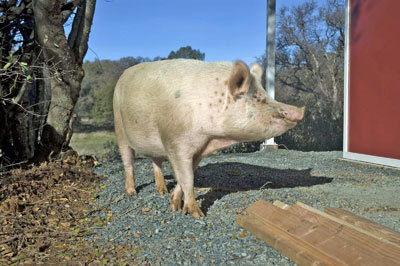
Think you’ve had a challenging moving-day experience? For J.P. Novic and her husband, Josh, moving to Grass Valley meant hammering out logistics to transport seven dogs, eight cats, 11 hens, three goats and two pigs.
It’s 5:30 a.m. on a Monday in a patch of forest on the side of Ben Lomond Mountain. Rising, Novic makes coffee for the arriving volunteers who will help load and haul the animals to a 1-square-mile sanctuary more than 200 miles away in Grass Valley.
Today, Novic, who founded the Center for Animal Protection and Education in 1992, is leaving Santa Cruz County for her longtime dream of building a sanctuary for the special animals C.A.P.E. rescues: the old, the sick, even the dying.
To some, these are throwaway lives, but the nonprofit believes that “animals have the right to a long, full life, free from pain and suffering.”
C.A.P.E.’s mission
Because C.A.P.E. hasn’t had a true sanctuary, animals are placed in volunteer foster homes, many with the Novics.
That was how Jessie came into their lives. He is a pit bull mix whose ears had been cut off and who had fallen from a second-story balcony. No one cared enough to get him medical attention.
Jessie was found crippled and arthritic, languishing in a local shelter, when the C.A.P.E. adoption manager spotted him. Although he was very skinny and wobbly, she knew he was a very loving dog.
On her once-a-week visits, Novic became his advocate and had him assessed for aggression before adoption.
“He is the gentlest giant you could meet,” says Novic, who now shares her home with Jessie. “When he‘s eating, he will move over for the Chihuahuas. You have to be nonjudgmental of animals. They just need a break. They just need that opportunity to feel secure.”
A new home
On moving day, transporting vehicles are lined up and 10 volunteers are helping load the trucks. Rooty the pig, despite his 350 to 400 pounds, is the easiest to move, because, as Novic says with a laugh, “If you have a bowl of food, he will follow you anywhere.”
A trail of cinnamon bread, apples and bananas leads him into the trailer he is sharing with a pot-bellied pig named Phoebe. She was rescued from hoarding owners who let their pot-bellied pigs mate indiscriminately.
Even though Phoebe is much smaller than Rooty, she’s harder to load because of her stubborn nature and bad eyesight.
“We have to keep saying, ‘We promise you you’re going to someplace you’ll love. You just have to trust us,’” Novic says.
Rooty was an abuse case going to slaughter when a neighbor asked the farmer if she could take him. As the piglet grew, however, she realized she could not care for him in the suburbs, and C.A.P.E. rescued him.
One special volunteer is missing today’s move. Tia Meyers, part of C.A.P.E.’s hospice program, is home sick. She spent hours with Rooty in his pen, barefoot and playing in the mud with him, baking him banana bread and sharing other baked goods with the animals.
“They were a big part of my life,” she says. “I do miss them, but I know they’ll be in a much better place where they can go free-ranging and browsing.”
Meyers was the first volunteer to accept a dog who had an incurable disease. Toby, a yellow Labrador, had a prognosis of less than three months to live.
“He saved my life. I was in a bad place. He was a gift,” she recalls. “Even though everyone thought I was doing this service for him, I never felt that. I knew he was in service to me. I would take him to the beach at night. We’d camp out together. We were inseparable.”
Toby lived an extra year and never needed any medication until the final few months of his life.
The new sanctuary
The caravan of five vehicles leaves at 11 a.m. Six hours later, the menagerie of people and animals arrives at C.A.P.E.’s Old Friends Animal Sanctuary in Grass Valley. The Novics have built a barn and other animal homes, along with a solar-paneled manufactured house and cabin for visitors.
It is dark, and after the animals are tucked in, the volunteers go next door to the Animal Place, a 600-acre farm animal rescue sanctuary, where they are welcomed with a warm vegan dinner.
The Novics have great dreams for the sanctuary, including an animal rights film festival and programs that invite people in to pet a cow and go for a tour, or perhaps work on behalf of animals or in the “veganic” garden, where no animal by-products are used. They hope to begin rescuing donkeys and horses and to create a vegan, collaborative community.
But for now, they will go to sleep and in the morning introduce their animal friends to their new forever home.
Watch a great video of the move by C.A.P.E. Program Manager Shelley Frost at www.youtube.com/watch?v=wQISevdJCFs&feature=youtube. Visit http://capeanimals.org to learn more about C.A.P.E. and their local dog rescue and adoption service.
– Carol Carson, M.Ed., is a naturalist, writer and educator.











